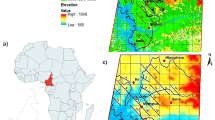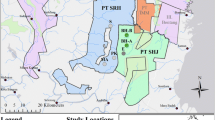Abstract
Primates living outside protected areas frequently come into conflict with humans. While the focus of most research has been on the costs and consequences of crop raiding in relation to subsistence agriculture, large-scale commercial agriculture presents conservation challenges of its own. Baboons that occupy commercial pine plantations in southern Africa often damage young trees and, consequently, are shot in large numbers. We here aim to describe the population structure and resource and habitat use by baboons in such areas to provide the data needed for the formulation of viable long-term conservation policies. We used radio-collars to obtain estimates of home range size and habitat usage from 2 plantation troops and detailed observation of 1 of these to determine their diet. We compared these data, together with counts of troop size, to those from individuals in the same population that did not enter plantation. Although the mean troop size (42.2) of baboons in plantations was significantly higher than in adjoining natural areas (18.3), population density (2.8 individuals/km2) did not differ. Plantation baboons had a comparatively restricted diet in which a few indigenous species were disproportionately represented. Pine cambium was not an important dietary component and the baboons generally avoided compartments of pine trees to forage in small pockets of various natural plant communities. We argue that foresters should shift their policy from one of baboon extirpation to the long-term management of local populations, in the context of a proper and ongoing evaluation of the discounted cost of baboon damage.




Similar content being viewed by others
References
Altmann, J. (1974). Observational study of behaviour: Sample methods. Behaviour, 49, 227–267.
Altmann, J., & Muruthi, P. (1988). Difference in daily life between semi-provisioned and wild-feeding baboons. American Journal of Primatology, 12, 213–221.
Ancrenaz, M., Dabek, L., & O’Neil, S. (2007). The costs of exclusion: Recognizing a role for local communities in biodiversity conservation. PLoS Biology, 5, e289.
Barbour, M. G., Burk, J. H., & Pitts, W. D. (1987). Terrestrial plant ecology. Menlo Park: Benjamin Cummings.
Bélisle, M. (2005). Measuring landscape connectivity: The challenge of behavioural landscape ecology. Ecology, 86, 1988–1995.
Bezuidenhout, H. (1993). Syntaxonomy and synecology of western Transvaal grasslands. South Africa: University of Pretoria.
Bredenkamp, G. J., Joubert, A. F., & Bezuidenhout, H. (1989). A reconnaissance survey of the vegetation of the plains in the Potchefstroom-Fochville-Parys Area. South African Journal of Botany, 55, 199–206.
Brown, L. R., & Bredenkamp, G. J. (1994). The phytosociology of the southern section of the Borakalalo Nature Reserve, South Africa. Koedoe, 37, 59–72.
Brown, L. R., Marais, A. J., Henzi, S. P., & Barrett, L. (2005). Vegetation classification as the basis for baboon management in the Bourke's Luck Section of the Blyde Canyon Nature Reserve, Mpumalanga. Koedoe, 48, 71–92.
Brown, L. R., Marais, A. J., Barrett, L., & Henzi, S. P. (2006). Habitat structure, population characteristics and resource utilisation by chacma baboons in commercial forestry areas of the Eastern Mpumalanga Escarpment. Report to Global Forestry Products and Komatiland Forests, Sabie, South Africa.
Dunbar, R. I. M. (1988). Primate social systems. London: Chapman and Hall.
Fergusson, R. A. (2005). Review of baboons, baboon damage and baboon control in South African plantation forests with particular reference to Mpumulanga Province. Report to the Baboon Damage Working Group of South Africa, Sabie, South Africa.
Forest Owners’ Association. (2002). Environmental guidelines for plantation forestry in South Africa. South Africa: Johannesburg.
Henzi, S. P., & Lycett, J. E. (1995). Population structure, dynamics and demography of mountain baboons. American Journal of Primatology, 35, 155–163.
Henzi, S. P., Byrne, R. W., & Whiten, A. (1992). Patterns of movement by baboons in the Drakensberg mountains: Primary responses to the environment. International Journal of Primatology, 13, 601–629.
Henzi, S. P., Lycett, J. E., & Piper, S. E. (1997). Fission and troop size in a mountain baboon population. Animal Behaviour, 53, 525–535.
Hill, C. M. (2000). Conflict of interest between people and baboons: Crop raiding in Uganda. International Journal of Primatology, 21, 299–315.
Hill, M. O. (1979). TWINSPAN: A Fortran program for arranging multivariate data in an ordered two-way table by classification of individuals and attributes. Ithaca: Cornell University.
Hill, R. A., & Dunbar, R. I. M. (1998). An evaluation of the roles of predation rate and predation risk as selective pressures on primate grouping behaviour. Behaviour, 135, 411–430.
Hooge, P. N., & Eichenlaub, B. (1997). Animal Movement Extension for ArcView. Anchorage: Alaska Science Centre, Biological Science Office, U.S. Geological Survey.
Katsvanga, C. A. T., Mudyiwa, S. M., & Gwenzi, D. (2006). Bark stripping and population dynamics of baboon troops after chemical control in pine plantations of Zimbabwe. African Journal of Ecology, 44, 413–416.
Katsvanga, C. A. T., Jimul, L., Zinner, D., & Mupangwa, J. F. (2009). Diet of pine plantation and non-plantation ranging baboon (Papio ursinus) groups with reference to bark consumption in the eastern highlands of Zimbabwe. Journal of Horticulture and Forestry, 1, 168–175.
Kavanagh, M. (1980). Invasion of the forest by an African savannah monkey: Behavioural adaptations. Behaviour, 73, 238–260.
Krebs, C. J. (1989). Ecological methodology. New York: Harper and Row.
Marais, A. J. (2005). Resource utilisation of the chacma baboon in different vegetation types in north-eastern mountain sour veld, Blyde Canyon Nature Reserve. M.Tech dissertation, University of South Africa.
Marais, A. J., Brown, L. R., Barrett, L., & Henzi, S. P. (2006). Population structure and habitat use of baboons (Papio hamadryas ursinus) in the Blyde Canyon Nature Reserve. Koedoe, 49, 67–76.
McNamara, L. M. (2005). Nutrient concentration of inner bark tissue in pine trees in Mpumulanga in relation to baboon damage. M.Sc. dissertation, University of the Witswatersrand.
Pienkowski, M. W., Watkinson, A. R., Kerby, G., Naughton-Treves, L., Treves, A., Chapman, C., et al. (1998). Temporal patterns of crop raiding by primates: Linking food availability in croplands and adjacent forest. Journal of Applied Ecology, 35, 596–606.
SAS Institute. (2007). JMP start statistics. Pacific Grove: Duxbury Press.
Acknowledgments
Funding for this project was provided by Global Forest Products and Komatiland Forests. We thank Global Forest Products for logistic support and access to the study areas; Mpumalanga Parks for approving this research and for supervising the capture of baboons; and Dr. Joanna Setchell and 2 anonymous referees for improving the manuscript.
Author information
Authors and Affiliations
Corresponding author
Rights and permissions
About this article
Cite this article
Henzi, S.P., Brown, L.R., Barrett, L. et al. Troop Size, Habitat Use, and Diet of Chacma Baboons (Papio hamadryas ursinus) in Commercial Pine Plantations: Implications for Management. Int J Primatol 32, 1020–1032 (2011). https://doi.org/10.1007/s10764-011-9519-6
Received:
Accepted:
Published:
Issue Date:
DOI: https://doi.org/10.1007/s10764-011-9519-6




